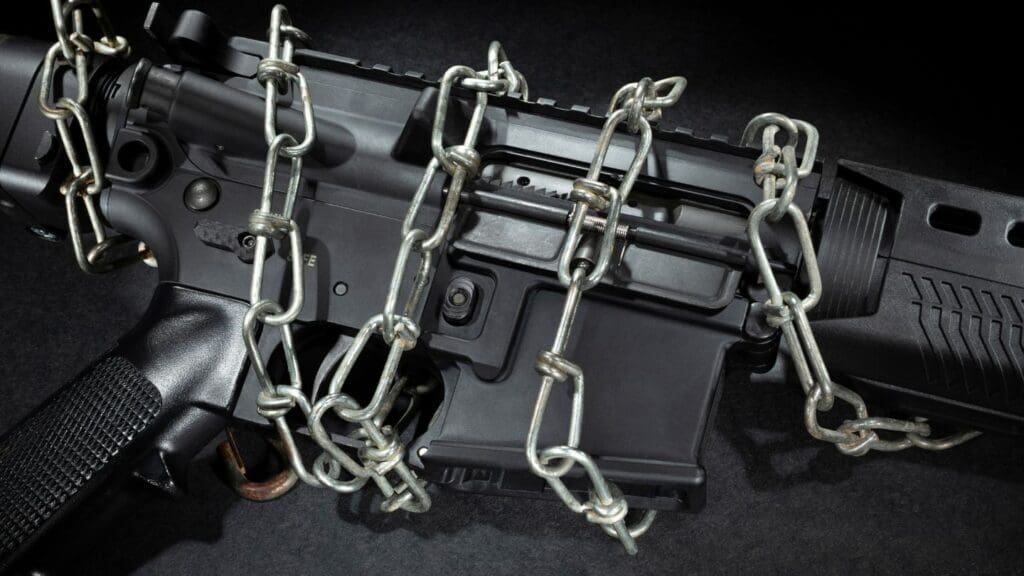Assault with a deadly weapon occurs when an individual uses an object capable of causing serious harm or death to injure or threaten another person. In this blog, we’ll explore the definition of assault with a deadly weapon, its legal criteria, penalties, common examples, and potential defenses—focusing on scenarios relevant to firearm owners and self-defense rights.
Key Takeaways
- Assault with a deadly weapon involves using an object capable of causing serious harm or death, and this crime carries significant legal consequences.
- For firearm owners, it’s essential to understand how self-defense laws apply to cases involving the use of a gun and know your rights in situations where you acted to protect yourself or others.
- The burden lies with the prosecution to prove intent to harm, making it critical for those accused to work with legal experts to present evidence of lawful self-defense.
Defining Assault with a Deadly Weapon
Assault with a deadly weapon is a legal term describing an aggravated form of assault involving the use of a weapon capable of inflicting serious harm or death. Under California law, this includes assaulting someone with a deadly weapon or using force likely to produce great bodily injury. It’s important to note that even if no actual harm occurs, an attempted battery with such a weapon can constitute assault.
For gun owners, this definition can overlap with self-defense scenarios. For example, using a firearm to defend yourself or others in a life-threatening situation may be legally justified under self-defense laws. However, the context and intent behind the use of a firearm are critical in determining whether the action qualifies as lawful self-defense or an assault with a deadly weapon.
What Is Considered a Deadly Weapon?

A deadly weapon is any object capable of causing serious injury or death, depending on how it is used. While firearms, knives, and brass knuckles are commonly recognized as deadly weapons, many everyday objects, such as glass bottles, vehicles, or even dogs, can also qualify under specific circumstances.
For lawful gun owners, firearms are tools primarily intended for personal protection. It’s essential to use them responsibly and within the confines of self-defense laws. In cases where a firearm is used to prevent imminent harm, it is often the context and evidence supporting the need for self-defense that determines whether the action is legally protected.
Legal Standards for Assault with a Deadly Weapon
To prove assault with a deadly weapon, the prosecution must demonstrate intent to cause great bodily harm and the use of a weapon capable of inflicting such harm. Importantly, the prosecution does not need to prove that actual harm occurred—only that the weapon had the potential for serious injury.
For firearm owners, intent plays a significant role. If a gun is fired or displayed during a confrontation, the defense can argue that it was a necessary response to an imminent threat. Self-defense laws protect individuals who use reasonable force, including firearms, to protect themselves or others from harm. The burden of proof often shifts to showing that the use of force was justified under the circumstances.
Examples of Assault with a Deadly Weapon

Real-life examples help clarify the concept of assault with a deadly weapon while also highlighting the role self-defense can play:
– Example 1: A heated parking lot argument escalates, and one individual uses a baseball bat to attack another. This is a clear case of assault with a deadly weapon.
– Example 2: In a home invasion scenario, a homeowner uses a firearm to defend their family from an armed intruder. Here, the use of the firearm would likely fall under self-defense laws, not assault.
– Example 3: During a road rage incident, someone brandishes a firearm to intimidate another driver. While the firearm wasn’t discharged, the intent behind its use could lead to charges of assault with a deadly weapon if not justified by self-defense.
These examples demonstrate the importance of understanding the context and intent behind actions involving weapons, particularly for firearm owners.
Penalties for Assault with a Deadly Weapon
Assault with a deadly weapon can result in severe penalties, including up to four years in prison and substantial fines. Cases involving firearms often carry harsher consequences. However, if the firearm was used lawfully in self-defense, these charges may not apply.
The severity of penalties depends on factors such as the type of weapon used, the extent of injuries, prior criminal records, and whether the act was premeditated. For gun owners, demonstrating lawful use of a firearm in self-defense can significantly reduce or eliminate penalties.
Common Defenses Against Assault with a Deadly Weapon Charges
Several defenses can be used to challenge assault with deadly weapon charges, especially for firearm owners:
– Self-defense: The most common defense for gun owners. If you use a firearm to protect yourself or others from imminent harm, this can justify your actions. Evidence such as witness testimony, surveillance footage, or injury reports can support this claim.
– Lack of Intent: If the weapon was used accidentally or without intent to harm, you can argue that the act does not meet the legal definition of assault.
– Mistaken Identity: If you can prove you were not the individual involved, this defense can clear your name.
Read more: How Often Are Guns Used in Self-Defense?
Importance of Legal Representation
If you’re a gun owner facing assault with deadly weapon charges, hiring an experienced attorney is critical. A skilled criminal defense attorney will understand firearm laws and self-defense statutes, helping to build a strong case that protects your rights. They can gather evidence, challenge the prosecution’s claims, and demonstrate that your actions were lawful and necessary.
Wrapping Up
Understanding assault with a deadly weapon is essential, particularly for responsible gun owners. While this offense carries serious legal consequences, actions taken in self-defense are often protected under the law. If you’ve been accused of such charges, seeking professional legal representation is crucial to protecting your rights.
If you or someone you know is facing charges involving a firearm, don’t face it alone. Lynne Torgerson, an experienced Minneapolis criminal defense attorney, is here to help. Lynne is dedicated to defending gun owners’ rights and ensuring your legal actions are properly represented. Get in touch today for a consultation and take the first step toward safeguarding your future.
Frequently Asked Questions
What is assault with a deadly weapon?
It’s an aggravated form of assault involving the use of an object capable of causing serious harm or death. For gun owners, lawful self-defense can often exempt them from such charges.
What can be considered a deadly weapon?
Deadly weapons include firearms, knives, vehicles, and even everyday items, depending on their use and intent. For responsible gun owners, using a firearm in self-defense is rarely classified as assault if justified.
How can someone defend against these charges?
Self-defense, lack of intent, and mistaken identity are common defenses. For firearm owners, proving the situation requires defensive action is key.
Why is legal representation important?
A skilled attorney can protect your rights, navigate complex firearm laws, and present a strong defense, especially when self-defense is a factor.



